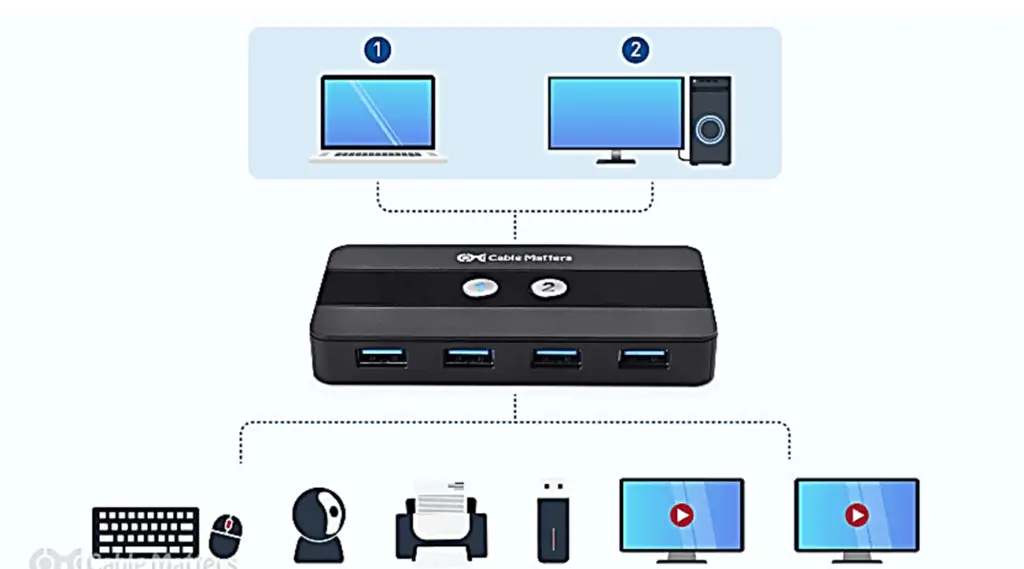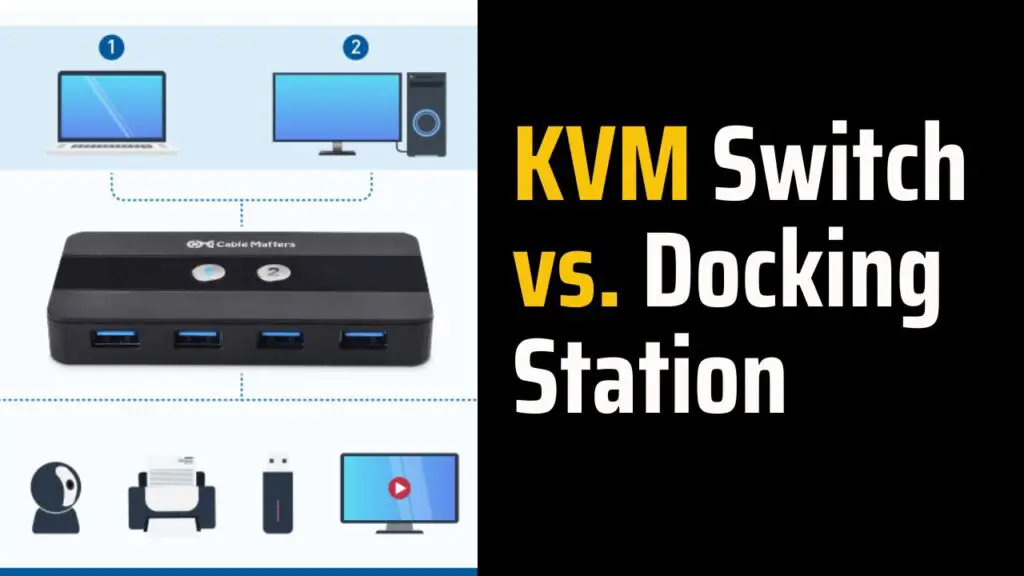Docking stations and KVM switches are specialized tools intended for distinct purposes, yet they collectively enhance the capabilities of a single device or set of peripherals. Their primary role is to ensure that when you’re ready to engage in your work, you have seamless access to all your essential data, devices, ports, accessories, and networks required to accomplish your critical tasks.
However, these are not the ordinary peripherals that come with every laptop or desktop; in the case of KVM switches, for example, they are highly specialized hardware purchases that even well-versed IT industry veterans might not have heard of.
Therefore, regardless of the type of work you do, understanding the differences between these two devices and how to use them to their full potential is an effective way to increase productivity.
KVM Switch
The purpose of a KVM switch is to facilitate the connection of many systems to a single set of peripherals, typically consisting of a keyboard and mouse. The acronym KVM, which stands for “keyboard, video, and mouse,” is indicative of its principal function.
In contrast to the conventional setup of desktop PCs and certain laptops, which need direct connection of a keyboard and mouse to their respective ports, a KVM switch operates by consolidating the keyboard and mouse, as well as other peripherals like webcams, headsets, printers, or scanners, into a single device.
By means of a single button press, users have the ability to select the system with which they want to interact.
In addition to a few output connections to connect devices through USB-C, USB-A, or occasionally USB-B, a standard KVM switch may have four USB-A 3.0 input ports for connecting different devices, such as a keyboard and mouse, webcam, headset, printer, or scanner. Then, it has a way to switch between the active device, which can be done with a remote control or buttons on the KVM switch itself.
Either way, the user can switch the system that the connected peripherals are interacting with a single button press. This increases productivity while connecting to several devices, especially if those systems are not easily accessible. By lowering the number of keyboards and mouse required for operating and using the hardware connected to the KVM switch, it also significantly reduces cable clutter and, eventually, costs.
If a user has a preference for a particular keyboard and mouse, such as a favorite mechanical keyboard switch or a mouse with a saved profile with helpful macros, the ability to keep such preferences across numerous computers and devices might be essential.

Docking Stations
A docking station is a valuable tool that serves to enhance the functionality and connectivity of laptops. These devices are equipped with different ports and connections and often have the capability to provide power via USB-C, if supported by your laptop. While docking stations have been available in various forms for as long as laptops have existed, their popularity has increased in recent years. Modern laptop designs have become increasingly slim, resulting in a significant reduction in the number and variety of ports and connectors.
In contrast to the past, when flagship laptop designs commonly featured an array of USB ports, external display outputs, RJ45 Ethernet connections, and a full-size card reader, modern designs often exhibit a limited number of USB-C ports.

The range of ports and connections provided by docking stations can exhibit significant differences in terms of sizes, price, and quality. Certain premium docking stations, for example, offer a variety of features and functionalities.
A potential docking station might provide many connectivity choices such as a Gigabit Ethernet port, four USB-A ports (containing both USB 2.0 and USB 3.0 types), twin DisplayPort outputs, and a USB-C host port capable of providing 80W of charging power for laptops.
The front of the device provides additional connectivity options such as a MicroSD and UHS-II SD card reader, dual 3.5mm jacks for headphones and a microphone, a USB-C 3.2 Gen 2 port with 18W fast charging capability through USB Power Delivery, and a USB-A 3.2 Gen 2 port with 10W fast charging capability.
These kinds of docking stations can greatly increase the hardware options of a modern laptop, especially in terms of connecting to several external monitors.
Docking Station vs. KVM Switch
The only real requirements for using a docking station are the docking station itself and a compatible laptop. Most docking stations typically come equipped with the necessary USB and power cables required for establishing connectivity and enabling functionality.
Users are now able to establish a wired network connection by connecting an Ethernet cable, access external storage with a USB-A drive, and conveniently attach additional peripherals such as keyboards and mice, as they have full access to all ports provided by the docking station. You shouldn’t need an additional cable of any kind to connect the docking station to your laptop, provided that your laptop is capable of sending and receiving display data through USB-C.
If you want to use an external display, you’ll need a DisplayPort, USB-C, or HDMI cable to connect it to the docking station.
It is important to note that while a laptop may possess Thunderbolt connectivity, certain docking stations that are designed to take USB-C connections may not necessarily provide Thunderbolt connectivity as well. Consequently, the docking station may not provide the complete bandwidth and feature support of Thunderbolt.
You should be even less concerned about KVM switches. Most KVM switches typically incorporate a comprehensive set of USB cables and adapters, facilitating the connection of various devices and systems, so enabling users to derive maximum utility from the switch. Nevertheless, it is important to note that the cables included with the KVM switch may vary depending on the exact model purchased.
Therefore, it is crucial to ensure that the chosen model includes the necessary connections for your requirements.
You can use any high-quality USB, DisplayPort, or HDMI cable or adapter for the task if you require more for the devices or systems you wish to connect. Just make sure you purchase the correct version of any USB accessories you buy. You don’t need to worry about USB version because USB-A, USB-B, and USB-C are very different from one another and cannot be used interchangeably, necessitating the need of adapters in some situations. Rather than the cable, the ports at both ends control the bandwidth that the connection offers.
While not all laptops and desktop computers can support such resolutions, some KVM switches, like some docking stations, can support external monitors up to 8K resolution. For instance, the MacBook and MacBook Pro series from Apple can only handle 4K resolution at 60Hz, which prevents them from taking full advantage of connected 8K or 4K 120Hz displays. Firmware updates may also be necessary for certain TVs and monitors before they connect to a KVM switch and display correctly.
KVM Switch vs. Docking Station: Choosing the Right Solution
The choice between a KVM switch and a docking station depends on your specific needs and use cases. Here are some considerations to help you decide:
- KVM Switch: Choose a KVM switch if you need to manage and switch between multiple computers or servers using a single set of input devices. This is ideal for users who work across different systems but prefer a unified input and output setup.
- Docking Station: Opt for a docking station if you primarily use a laptop or portable device and require enhanced connectivity to peripherals, external displays, and accessories. Docking stations are perfect for creating a versatile, organized, and productive workspace.
USB-C Docking Stations With KVM Switch
It’s common for users to need a docking station that acts as a KVM switch. This need will be familiar to you if you have an Ultrabook that doesn’t have enough ports for a seamless connection. If you use a docking station, you can get more ports, but you’ll have to give up a port that is already in short supply.
A docking station with a built-in KVM switch would be an appropriate solution in this case. The problem is that docking stations don’t come with built-in KVM switch, and you won’t be able to find one online. However, there are a few options you might think about to meet this need.
A variety of the latest ports, such as USB-C, DisplayPort, Ethernet ports, and other types, are available on many USB-C KVM switches. Since it’s a KVM switch, connecting two computers and using their respective port selections, just like you would with a docking station, is simple.
One potential method for increasing the range of connectivity options in a setup involves the addition of a docking station into one of the peripheral ports on a Thunderbolt/USB-C KVM switch.
Technology
- What is a KVM Switch?
- How Does 4-In-1-Out KVM Switch Work?
- Synergy vs. KVM Switches
- Benefits of Using an EDID Emulator
- Benefits of Docking Stations
- What Is Thunderbolt 4?
- Type A, B and C USB Cable
- Video Upscaling and Video Downscaling
- How Do KVM Extenders Work for Home Security Systems?
- Over the Top (OTT) and Video On Demand (VOD)
- Benefits of Getting a Dual DP KVM Switch
- HDMI over IP vs HDBaseT
- How to Share a KVM Docking Station with Two Computers?
- DisplayPort Interface for Gaming & Graphic Design
- DisplayPort 1.4 vs. HDMI 2.1
- How to Build an Effective HDMI over IP System in a Shopping Mall?
- Tips to Fix Screen Flickering Issues
- What is Display Stream Compression?
- How to Use Daisy Chain When Connecting Multiple Monitors?
- HDMI Encoders & Decoders
- Tips for Purchasing a KVM Switch for Macbook
- Which Cable Do I Need For 144Hz?
- USB-C vs. Thunderbolt
- Does DisplayPort Support 144Hz?
- Nvidia RTX 3080 vs. 3080-Ti
- BYOD vs. BYOM:
- Does Epson Make a True 4K Projector?
- Difference between 3080 and 3090
PC
- CPU for NVIDIA GeForce RTX 4080
- $2500 Gaming PC Build
- Gaming PC Under $500
- PC Cases Under $100
- Components for 4K $2500 Gaming PC
- Cases for RTX 4070
- PC Tower Cases
- CPUs for RTX 4080
- Full Tower PC Cases
- Open Air PC Cases
- Cases for RTX 4080
Laptops
Monitor
- 240Hz vs 360Hz Monitors
- Do You Need a 4K Monitor for Video Editing?
- Benefits of 4K Resolution in Gaming
- Are there 4K monitors with 240 Hz?
- Is 8K Resolution Worth It for Video Editing?
- What Is the Lifespan of a 4K Monitor?
- 4K Upscaling and Native 4K
- Is a Graphics Card Necessary for a 4K Monitor?
- What’s the Ideal Size for a 4K Monitor?
- Can a 4K TV Be Used as a Monitor?
- Thunderbolt Monitors
- Monitors with In-Built KVM Switches
- Affordable Thunderbolt Monitors
- Dell Thunderbolt Monitors
- Monitors with Docking Stations
- Curved Monitors with Built-in KVM
- Thunderbolt Monitors for Mac
Motherboard
KVM Switches
- KVM Switches for Dual Monitors
- USB-C KVM Switches
- Thunderbolt Docks
- Docking Stations for Dual Monitors
- KVM Switches
- USB-C Docking Stations
- USB-C Hubs and Dongles
- Gaming Laptop Docking Stations
- KVM Switch For Macbook
- KVM Switches For Gamer
- Affordable Docking Stations for MacBook Pro
- KVM switches for Laptops
- Triple Monitor KVM Switch



